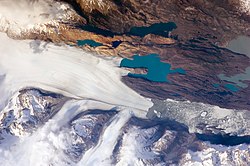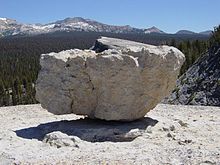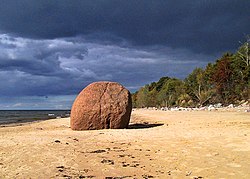Glacial erratic


A glacial erratic is a
Geologists identify erratics by studying the rocks surrounding the position of the erratic and the composition of the erratic itself. Erratics are significant because:
- They can be transported by glaciers, and are thereby one of a series of indicators which mark the path of prehistoric glacier movement. Their lithographic origin can be traced to the parent bedrock, allowing for confirmation of the ice flow route.
- They can be transported by Lake Missoula. Erratics released by ice rafts that were stranded and subsequently melted, dropping their load, allow characterization of the high-water marks for transient floods in areas like temporary Lake Lewis.
- Erratics dropped by icebergs melting in the ocean can be used to track Antarctic and Arctic-region glacial movements for periods prior to record retention. Also known as dropstones, these can be correlated with ocean temperatures and levels to better understand and calibrate models of the global climate.[1]
Formation of erratics
The term "erratic" is commonly used to refer to erratic blocks, which geologist Archibald Geikie describes as: "large masses of rock, often as big as a house, that have been transported by glacier ice, and have been lodged in a prominent position in the glacier valleys or have been scattered over hills and plains. And examination of their mineralogical character leads the identification of their sources...".[2] In geology, an erratic is material moved by geologic forces from one location to another, usually by a glacier.
Erratics are formed by glacial ice erosion resulting from the movement of ice. Glaciers erode by multiple processes including:
- glacial till.
- Plucking – pieces of bedrock are cracked off by glaciers, producing larger erratics.
- Ice thrusting – the glacier freezes to its bed, moving large sheets of frozen sediment at its base along with it.
- Glacially induced spalling – layers of rock are spalled off the rocks below the glacier during ice lens formation. This provides smaller debris, which is ground into the glacial basal material, to become till.[3][4]

Evidence supports another possibility for the creation of erratics as well: rock avalanches onto the upper surface of the glacier (supraglacial). Rock avalanche–supraglacial transport occurs when the glacier undercuts a rock face, which fails by avalanche onto the upper surface of the glacier. The characteristics of rock avalanche–supraglacial transport includes:[5]
- Monolithologic composition – a cluster of boulders of similar composition are frequently found in close proximity. Commingling of the multiple lithologies normally present throughout the glaciated basin, has not occurred.[5]
- Angularity – the supraglacially transported rocks tend to be rough and irregular, with no sign of subglacial abrasion. The sides of boulders are roughly planar, suggesting that some surfaces may be original fracture planes.[5]
- Great size – the size distribution of the boulders tends to be skewed toward larger boulders than those produced subglacially.[5]
- Surficial positioning of the boulders – the boulders are positioned on the surface of glacial deposits, as opposed to partially or totally buried.[5]
- Restricted areal extents – the boulder fields tend to have limited areal extent; the boulders cluster together, consistent with the boulders landing on the surface of the glacier and subsequently deposited on top of the glacial drift.[5]
- Orientations – the boulders may be close enough that original fracture planes can be matched.[5]
- Locations of the boulder trains – the boulders appear in rows, trains or clusters along the lateral moraines as opposed to being located on the terminal moraine or in the general glacial field.[5]
- Monolithologic composition – a cluster of boulders of similar composition are frequently found in close proximity. Commingling of the multiple
Glacier-borne erratic

Erratics provide an important tool in characterizing the directions of glacier flows, which are routinely reconstructed used on a combination of moraines, eskers, drumlins, meltwater channels and similar data. Erratic distributions and glacial till properties allow for identification of the source rock from which they derive, which confirms the flow direction, particularly when the erratic source outcrop is unique to a limited locality. Erratic materials may be transported by multiple glacier flows prior to their deposition, which can complicate the reconstruction of the glacial flow.[6]
Ice-rafted erratic
Glacial ice entrains debris of varying sizes from small particles to extremely large masses of rock. This debris is transported to the coast by glacier ice and released during the production, drift and melting of icebergs. The rate of debris release by ice depends upon the size of the ice mass in which it is carried as well as the temperature of the ocean through which the ice floe passes.[7][8]
Sediments from the late
The location and altitude of ice-rafted boulders relative to the modern landscape has been used to identify the highest level of water in proglacial lakes (e.g. Lake Musselshell in central Montana) and temporary lakes (e.g. Lake Lewis in Washington state). Ice-rafted debris is deposited when the iceberg strands on the shore and subsequently melts, or drops out of the ice floe as it melts. Hence all erratic deposits are deposited below the actual high water level of the lake; however, the measured altitude of ice-rafted debris can be used to estimate the lake surface elevation.

This is accomplished by recognizing that on a fresh-water lake, the iceberg floats until the volume of its ice-rafted debris exceeds 5% of the volume of the iceberg. Therefore, a correlation between the iceberg size and the boulder size can be established. For example, a 1.5-metre-diameter (5 ft) boulder can be carried by a 3-metre-high (10 ft) iceberg and could be found stranded at higher elevations than a 2-metre (7 ft) boulder, which requires a 4-metre-high (13 ft) iceberg.[9]
Large erratics


Large erratics consisting of slabs of bedrock that have been lifted and transported by glacier ice to subsequently be stranded above thin glacial or
Nonglacial erratics
In geology an erratic is any material which is not native to the immediate locale but has been transported from elsewhere. The most common examples of erratics are associated with glacial transport, either by direct glacier-borne transport or by ice rafting. However, other erratics have been identified as the result of kelp holdfasts, which have been documented to transport rocks up to 40 centimetres (16 in) in diameter, rocks entangled in the roots of drifting logs, and even in transport of stones accumulated in the stomachs of pinnipeds during foraging.[11]
History

During the 18th century, erratics were deemed a major geological paradox. Geologists identify erratics by studying the rocks surrounding the position of the erratic and the rock of the erratic itself. Erratics were once considered evidence of a
In the 19th century, many scientists came to favor erratics as evidence for the end of the ice age 10,000 years ago, rather than a flood. Geologists have suggested that landslides or rockfalls initially dropped the rocks on top of glacial ice. The glaciers continued to move, carrying the rocks with them. When the ice melted, the erratics were left in their present locations.
Charles Darwin published extensively on geologic phenomena including the distribution of erratic boulders. In his accounts written during the voyage of HMS Beagle, Darwin observed a number of large erratic boulders of notable size south of the Strait of Magellan, Tierra del Fuego and attributed them to ice rafting from Antarctica. Recent research suggests that they are more likely the result of glacial ice flows carrying the boulders to their current locations.[16]
Examples
Glacier-borne erratics

Australia
- Exhumed erratics eroded from unconsolidated 270 Ma Permian glacial sediments can be found on the beach and in the park at Hallett Cove Conservation Park just south of Adelaide, and in other South Australian locations, such as Inman Valley.
Canada
- Big Rock near Okotoks, Alberta, Canada. It is the largest erratic in the Foothills Erratics Train.
- Bleasdell Boulder, southern Ontario, was described as "glacial" in origin by Reverend William Bleasdell in 1872.[17]
- The province.
- White Rock, British Columbia gets its name from a coastal erratic the size of a garage[clarification needed] found on the beach at Semiahmoo Bay, right at the border with Washington.
- Boulder in Green Timbers Urban Forest in Surrey, British Columbia, described as a glacial erratic on the city website

Glacial erratic in Green Timbers Urban Forest, in Surrey, BC, Canada
Estonia
- Ehalkivi (Sunset Glow Boulder) near Letipea, Estonia is the largest erratic boulder in the glaciation area of North Europe. Height 7 m, circumference 48.2 m, a volume of 930 m3 and a mass of approx 2,500 tonnes
Finland

- Kukkarokivi, located close to Turku at the Ruissalo island in Southwest Finland. It is the largest in Finland; length about 40 m, width about 30 m, height 12 m, weight about 36,000 tonnes.
Germany
- Colossus of Ostermunzel, Lower Saxony
- Der Alte Schwede, found during dredging of the river Elbe near Hamburg in 1999; oldest in Germany
- Giebichenstein, Stöckse, Lower Saxony
- Glacial erratics on and around Rügen
Republic of Ireland
- The Clonfinlough Stone, located in central Ireland, is covered with Bronze Age and medieval carvings
Latvia
- Nīcgale Great Stone, located in Nīcgale Parish
- Brodu quarry stone, located in Jēkabpils
- Lauču stone, located in Lauči, Skulte parish, Limbaži municipality. Believed to have separated from a glacier in the Vyborg area of Southern Finland and Russia.[18]

Lithuania

Poland
- Trygław, Tychowo
- Devil Stone, Kashubia
- Glacial erratic on Wolności Square in Racibórz
- Glacial erratic in Sulechów
United Kingdom
England
- The Crosby Erratic, Coronation Park, Liverpool, England; unearthed in a field nearby in 1898.[19]
- The Great Stone of Fourstones, at the county boundary between North Yorkshire and Lancashire, has fifteen steps carved in its side to enable it to be climbed.

- The Hitching Stone in North Yorkshire. It is the largest erratic block in the county.[20]
- The Merton Stone, Merton, Norfolk
- The Norber erratics in the Yorkshire Dales are one of England's finest sets of glacial erratics.
Scotland
- Jim Crow Rock, glacial erratic in Hunters Quay, situated on the foreshore of the Firth of Clyde. The rock has been the subject of controversy because of an allegedly racist face painted on it.
Northern Ireland
- Cloughmore, near Rostrevor in County Down, Northern Ireland, is a glacial erratic found on the mountain high above the village. Located on the slopes of Slieve Martin, the stone overlooks Carlingford Lough and the Cooley Peninsula.
United States


- Bubble Rock, perched on the edge of a cliff near the summit of South Bubble mountain in Acadia National Park, Maine.
- Doane Rock, the largest exposed boulder in Cape Cod, Massachusetts.
- Fantastic Erratic, a fern-covered erratic the size of a two-car garage, is found on Cougar Mountain near Seattle.
- Glen Rock, a boulder weighing 570 short tons (520 t) in Glen Rock, New Jersey, believed to have been carried to the site by a glacier that picked up the rock 15,000 years ago near Peekskill, New York.
- Indian Rock in Montebello, New York is a large glacial erratic boulder of granite gneiss, formed in the Proterozoic (Precambrian) era, 1.2 billion to 800 million years ago. It is estimated to weigh ≈17,300 tons.
- Madison Boulder, a 5,000-short-ton (4,500 t) glacial erratic the size of a large house in Madison, New Hampshire.
- Olmsted Point in Yosemite National Park is noteworthy for having granite hills covered in numerous small glacial erratics.
- Pilgrimslanded in 1620. It is an important symbol in American history.
- porphyritic granite boulder that was originally located at the summit of Rollstone Hill in Fitchburg, Massachusetts. It was carried by the last glaciation from central New Hampshire. Threatened by quarrying operations, it was moved to Litchfield Park in downtown Fitchburg in 1929–1930.
- The northern portion of the town of Waterville, Washington has a large number of large basalt erratics, particularly along the moraine running east–west from McNeil Canyon.
- Tripod Rock in Kinnelon, New Jersey is noteworthy for being perched on three smaller boulders.
- Balance Rock in Princeton, Massachusetts is located at the base of Mount Wachusett, on the northwest side.
Flood-borne erratics
If glacial ice is "rafted" by a flood such as that created when the ice dam broke during the Missoula floods, then the erratics are deposited where the ice finally releases its debris load. One of the more unusual examples is found far from its origin in Idaho at Erratic Rock State Natural Site just outside McMinnville, Oregon. The park includes a 40-short-ton (36 t) specimen, the largest erratic found in the Willamette Valley.
See also
- Balancing rock
- Glacial erratic boulders of the Puget Sound region
- Grannie stone
- List of individual rocks
- Jasper conglomerate
- Sunday Rock
- Willamette Meteorite
References
- .
- ^ Geikie, Sir Archibald (1882). "Textbook of geology". Macmillan. Retrieved 2009-12-12.
erratic glacier.
{{cite journal}}: Cite journal requires|journal=(help) - doi:10.1038/ngeo186.
- S2CID 11082114.
- ^ .
- . Retrieved 10 September 2013.
- ^ S2CID 4339371.
- .
- .
- .
- .
- ISBN 0674883829.
- ^ Principles of Geology, Volume 1; Sir Charles Lyell - Geology - 1830
- ^ a b E.P. Evans: "The Authorship of the Glacial Theory", North American review Volume 145, Issue 368, July 1887. Accessed on 25 February 2008.
- ^ Cameron, Dorothy (1964). Early discoverers XXII, Goethe-Discoverer of the ice age. Journal of glaciology (PDF). Archived from the original (PDF) on 2019-12-15. Retrieved 2016-03-18.
- ^ Edward B. Evenson, Patrick A. Burkhart, John C. Gosse, Gregory S. Baker, Dan Jackofsky, Andres Meglioli, Ian Dalziel, Stefan Kraus, Richard B. Alley, Claudio Berti; "Enigmatic boulder trains, supraglacial rock avalanches, and the origin of "Darwin's boulders", Tierra del Fuego; GSA Today; Volume 19 Issue 12 (December 2009); pp. 4–10
- S2CID 129757092.
- ^ "Lauču(Lauchu) stones - vidlauci.lv". www.vidlauci.lv. Retrieved 2021-07-04.
- ^ "Glacial erratic - Coronation Park, Crosby". Geograph UK.
- ^ "On the Bradford District's Western Boundary". www.bradfordhistorical.org.uk. Retrieved 2018-06-02.
- ^ "Soulbury stone: White lines 'horrific' and 'an eyesore'". BBC. 16 April 2016.
- Imbrie, J. & K. P. Imbrie. Ice Ages, Enslow Publishers, Hillside, New Jersey, 1979.
External links
![]() Media related to Glacial erratics at Wikimedia Commons
Media related to Glacial erratics at Wikimedia Commons

